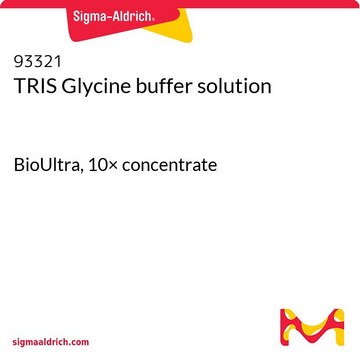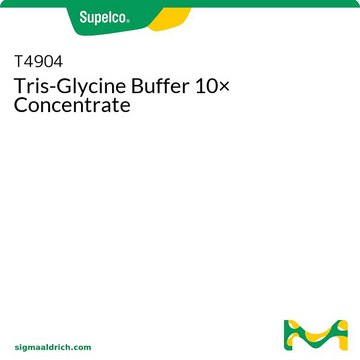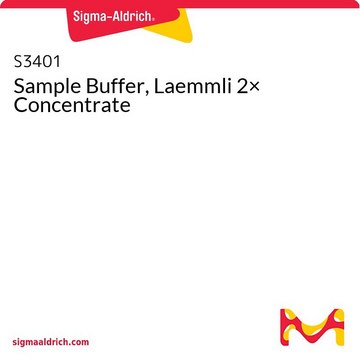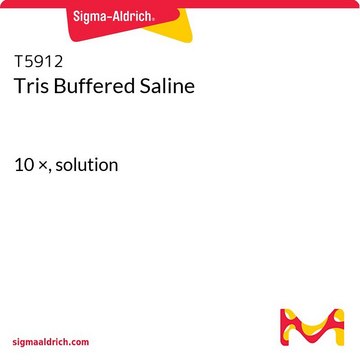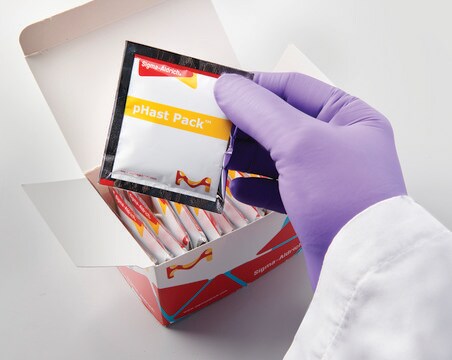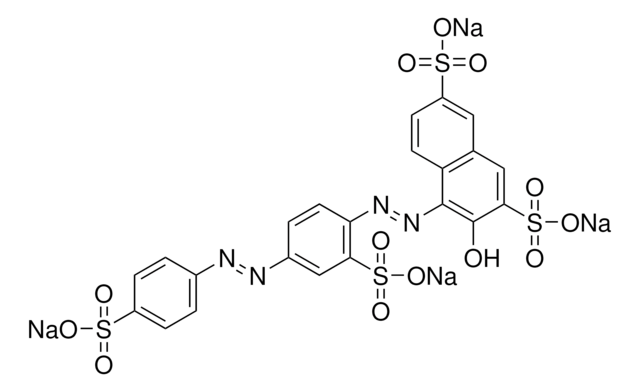T7777
TRIS glycine SDS buffe solution
Synonyme(s) :
TRIS glycine SDS buffer solution
Se connecterpour consulter vos tarifs contractuels et ceux de votre entreprise/organisme
About This Item
Code UNSPSC :
41105319
eCl@ss :
32129211
Nomenclature NACRES :
NA.25
Produits recommandés
Stérilité
0.2 μm filtered
Niveau de qualité
Forme
liquid
Application(s)
diagnostic assay manufacturing
Température de stockage
2-8°C
Vous recherchez des produits similaires ? Visite Guide de comparaison des produits
Description générale
Tris-glycine-SDS (TGS) running buffer is the most commonly used buffer for sodium dodecyl sulfate-polyacrylamide gel electrophoresis (SDS-PAGE) of proteins. TGS is usually used for both anode and cathode buffer. Recommended running conditions is 150 volts for mini vertical gel electrophoresis units.
Application
Tris-glycine-SDS buffer 10× concentrate has been used as a running buffer in sodium dodecyl sulfate-polyacryamide gel electrophoresis (SDS-PAGE). It is also used to block membranes with 5% non-fat dry milk for western blotting. TGS is usually used for both the anode buffer and the cathode buffer. Recommended running conditions is 150 volts for mini vertical gel electrophoresis units.
Reconstitution
Dilution of the 10× TGS buffer produces a 1× running buffer containing 25 mM Tris, 192 mM glycine and 0.1% SDS, pH approx. 8.6.
Code de la classe de stockage
10 - Combustible liquids
Classe de danger pour l'eau (WGK)
WGK 1
Point d'éclair (°F)
Not applicable
Point d'éclair (°C)
Not applicable
Équipement de protection individuelle
Eyeshields, Gloves, type ABEK (EN14387) respirator filter
Faites votre choix parmi les versions les plus récentes :
Déjà en possession de ce produit ?
Retrouvez la documentation relative aux produits que vous avez récemment achetés dans la Bibliothèque de documents.
Antitumor Activity and Mechanism of a Reverse Transcriptase Inhibitor, Dapivirine, in Glioblastoma
Liu W, et al.
Journal of Cancer, 117?128-117?128 (2018)
Multiple tandem epitope tagging for enhanced detection of protein expressed in mammalian cells
Zhang L, et al.
Molecular Biotechnology, 19(3), 313-321 (2001)
A Radioisotope-free Oligosaccharyltransferase Assay Method
Yamasaki T and Kohda D
Glycobiology (2007)
Man-Lan Guo et al.
Cell biochemistry and function, 37(2), 72-83 (2019-02-19)
Cancer cell progression and proliferation increase cell density, resulting in changes to the tumour site, including the microenvironment. What is not known is if increased cell density influences the aggressiveness of cancer cells, especially their proliferation, migration, and invasion capabilities.
Weiwen Liu et al.
The Journal of dermatology, 48(3), 289-300 (2020-12-02)
Androgenetic alopecia is the most common form of hair loss disorder. The features of this process are shortening of the anagen phase in hair cycling and progressive miniaturization of the hair follicle. However, the mechanisms in androgenetic alopecia are still
Notre équipe de scientifiques dispose d'une expérience dans tous les secteurs de la recherche, notamment en sciences de la vie, science des matériaux, synthèse chimique, chromatographie, analyse et dans de nombreux autres domaines..
Contacter notre Service technique